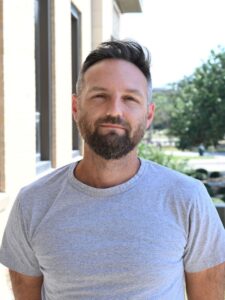TAMU Biology Welcomes Four New Faculty in 2024
2024 was a banner year for the Texas A&M University Biology Department in terms of faculty recruiting and growth. Four new researchers joined the outstanding Biology Department faculty – Dr. Jared Bard, Dr. Jason Karpac, Dr. Joshua Lillvis, and Dr. Matthew Moulton. Their cutting-edge research programs closely align with existing areas of expertise in the Biology Department, and their innovative contributions will add fuel to the fire of discovery as the Biology Department continues to grow. To learn more about each of the new faculty members, check out brief summaries of their research programs below.

Jared Bard, PhD
Hometown: Hartford, CT
Training History: Bachelors, Yale University. PhD, UC Berkeley. Postdoctoral fellowship, University of Chicago.
Key Words: cell stress, stress granules, biomolecular condensates, cancer, Chikungunya virus, RNA
Research Tools: biophysics, biochemistry, high-throughput techniques, cell culture, viruses
Broader Impact: developing treatments for cancer and viral infection
Favorite thing about being an Aggie: teaching biology to students from so many different backgrounds.
Research Interest: The Bard Lab aims to understand how cells respond to stress. The cellular stress response can be triggered by many external factors, and the cell does lots of different things in an attempt to resolve this stress. The Bard Lab uses two different cell stress models – viral infection and “stress-resistant” cancer cells – to try to understand how cells respond to stress. Specifically, the Bard Lab is most interested in how and why the cell aggregates molecules into clusters termed “biomolecular condensates” in response to stress and viral infection. This research both contributes to our fundamental understanding of how cells work and holds promise for therapies across various diseases, since cell stress is a common feature of many pathological states.

Jason Karpac, PhD
Hometown: Pittsburgh, PA
Training History: Bachelors, Grove City College. PhD, Oklahoma Health Sciences Center. Postdoctoral fellowship, University of Rochester and the Buck Institute for Research on Aging.
Key Words: metabolism, immunity, aging, signaling networks
Research Tools: Drosophila melanogaster
Broader Impact: identifying novel metabolic targets that underlie disease susceptibility
Favorite thing about being an Aggie: exposure to the scientific and academic diversity across campus.
Research Interest: The Karpac Lab studies a fundamental component of life: cellular metabolism. Cells need to take in, store, and use energy to live (just like we do). However, the way cells regulate this complex process in response to a flurry of information is not well understood. Appropriately regulating metabolism is one of the earliest problems cells had to solve way back at the origin of life as we know it, so the signaling pathways controlling cellular metabolism are ancient and very similar across many multicellular organisms. The Karpac Lab therefore uses the model system Drosophila melanogaster (fruit fly) to understand how the puzzle pieces of metabolic signaling fit together, both within and outside of the cell on the scale of tissues and organs. This research has broad applications for human health – for example, changes in cellular metabolism are a hallmark of cancer and infection susceptibility and could therefore be targeted for therapies.

Matthew Moulton, PhD
Hometown: Centerville, UT
Training History: Bachelors, Brigham Young University. PhD, University of Utah. Postdoctoral fellowship, Baylor College of Medicine.
Key Words: Alzheimer’s, neuroscience, humanization, genetics, glia, lipid droplet, neurodegeneration
Research Tools: humanized Drosophila melanogaster, gene editing, confocal microscopy, electroretinogram
Broader Impact: identifying mechanisms of neurodegenerative diseases for therapeutic intervention
Favorite thing about being an Aggie: having a community of great people working together and helping each other.
Research Interest: Neurodegenerative diseases like Alzheimer’s disease significantly impact human quality of life. Despite the dedication of countless scientists, there is still a lot we don’t know about what happens in Alzheimer’s disease and how to stop or reverse its effects on the brain. The Moulton Lab is dedicated to tackling these questions. Specifically, the Moulton Lab studies the role of lipid droplets in glial cells in the brain which accumulate in disease. Their research focuses on mimicking the nuances of human disease as closely as possible by inserting human genes into their model system, Drosophila melanogaster. This way, they can directly study the impact of mutations in human genes on glial lipid droplet formation and neurodegeneration. The Moulton Lab hopes to contribute to finding better therapies for treating and preventing Alzheimer’s disease.

Joshua Lillvis, PhD
Hometown: Ashtabula, Ohio
Training History: Bachelors, Ohio State University. PhD, Georgia State University. Postdoctoral fellowship, The Research Institute of Molecular Pathology & Janelia Research Campus.
Key Words: behavior, neuroscience, genetics, neural circuits, individual variation, physiology, evolution
Research Tools: Drosophila (different species), gene editing, optogenetics, live calcium imaging, expansion microscopy, behavioral analysis, electrophysiology
Broader Impact: learning about the neural basis of behavior and understanding the evolution of brain structure and behavior
Favorite thing about being an Aggie: the people!
Research Interest: The Lillvis Lab is dedicated to understanding the genetic and neurobiological determinants of behavior variation across individuals and species. It is well known that individuals within the same species and across different species can react in distinct ways to identical stimuli, but we know very little about where this behavior variation comes from in the nervous system. The Lillvis Lab uses cutting-edge research tools to identify variations in genetics and neurobiology that are linked to behavior variability between individuals and closely related species. Specifically, they leverage the powerful experimental toolkit available in Drosophila melanogaster to learn how variations in the structure, physiology, and function of neural networks give rise to variations in courtship song behaviors. Because the principles of nervous systems are largely conserved between flies and humans, the Lillvis Lab’s research will teach us more about what it means to be human and why we are the way we are (the “neural basis of behavior”).
If you see these new faculty members around, be sure to say howdy! These labs are all actively recruiting new lab members, so check out their research and consider getting involved in their work at the ground floor.





